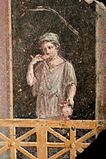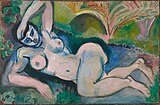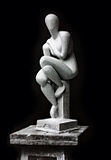Figurative Art
Figurative art is itself based upon a tacit understanding of abstracted shapes: the figure sculpture of Greek antiquity was not naturalistic, for its forms were idealized and geometric.[3] Ernst Gombrich referred to the strictures of this schematic imagery, the adherence to that which was already known, rather than that which is seen, as the “Egyptian method”, an allusion to the memory-based clarity of imagery in Egyptian art.[4] Eventually idealization gave way to observation, and a figurative art which balanced ideal geometry with greater realism was seen in Classical sculpture by 480 B.C.[3] The Greeks referred to the reliance on visual observation as mimesis. Until the time of the Impressionists, figurative art was characterized by attempts to reconcile these opposing principles.[4]
From the early Renaissance, Mannerism and the Baroque through 18th-, 19th- and 20th-century painting Figurative art has steadily broadened its parameters. Nicolas Poussin (1594-1665), a French painter in the classical style whose work predominantly features clarity, logic, and order, and favors line over color; served as an alternative to the more narrative Baroque style of the 17th century. He was a major inspiration for such classically-oriented artists as Jacques-Louis David, Jean-Auguste-Dominique Ingres and Paul Cézanne. The rise of the Neoclassical art of Jacques-Louis David ultimately engendered the realistic reactions of Gustave Courbet and Édouard Manet leading to the multi-faceted figurative art of the 20th century.
Figurative art of the individual human form
[one_half]
-
Ancient Roman woman on a balcony (9–14 CE), Getty Villa
-
Ingres, The Valpinçon Bather(1808), Louvre
-
Paul Cézanne, Bather (1885-1887), Museum of Modern Art
-
Jacek Malczewski, winged lionChimera (1906), National Museum, Warsaw
-
Raymond Duchamp-Villon,Femme assise (1914), plaster
-
Ian Hornak, Marcia Sewing, Variation III (1978), Museum of Fine Arts, Boston
[/one_half] [one_half_last]
Groups of human figures
-
Ancient Egyptian painting
-
Giotto, The Lamentation (c. 1305), Scrovegni Chapel
-
Kam?l ud-D?n Behz?d, The construction of castle Khornaq in al-Hira (c. 1494-1495)
-
El Greco, The Opening of the Fifth Seal (1608-1614),Metropolitan Museum of Art, New York City
-
Rubens, Judgement of Paris (c. 1636), National Gallery, London
-
Poussin, Et in Arcadia ego (Les Bergers d’Arcadie) (late 1630s),Louvre
-
Delacroix, The Barque of Dante(1822), Louvre
-
Courbet, A Burial at Ornans(1849-1850), Musee d’Orsay, Paris
-
Édouard Manet, The Old Musician (1862), National Gallery of Art, Washington, DC
-
Degas, Ballet Rehearsal (1873),Fogg Art Museum, Cambridge, Massachusetts
-
Renoir, Dance at Le Moulin de la Galette (Bal du moulin de la Galette) (1876), Musée d’Orsay
-
Auguste Rodin, The three shades (Les Trois Ombres), for the top of The Gates of Hell(before 1886)
-
Paul Gauguin, The Midday Nap(1894)
-
John French Sloan, McSorley’s Bar (1912), Detroit Institute of Arts
-
Ernst Kirchner, Berlin Street(1913)
-
George Bellows, Dempsey and Firpo (1924), Whitney Museum of American Art
[/one_half_last]



























